The Bundesliga has finally returned, albeit without supporters in the stadium, and RB Leipzig welcomed SC Freiburg to Red Bull Arena for matchday 26. The long layoff from games definitely impacted all clubs around the Bundesliga, with players not being as sharp or fit as they were prior to the postponement of games. Christian Streich’s Freiburg were able to ward off Julian Nagelmann’s RB Leipzig for long periods of the match, earning themselves a 1-1 draw by taking advantage of their set-pieces.
This tactical analysis will examine the tactics used by both Leipzig and Freiburg in this Bundesliga match. The analysis will highlight how Leipzig looked to attack Freiburg through multiple phases of the game, resulting in them ultimately being held at bay.
Lineups
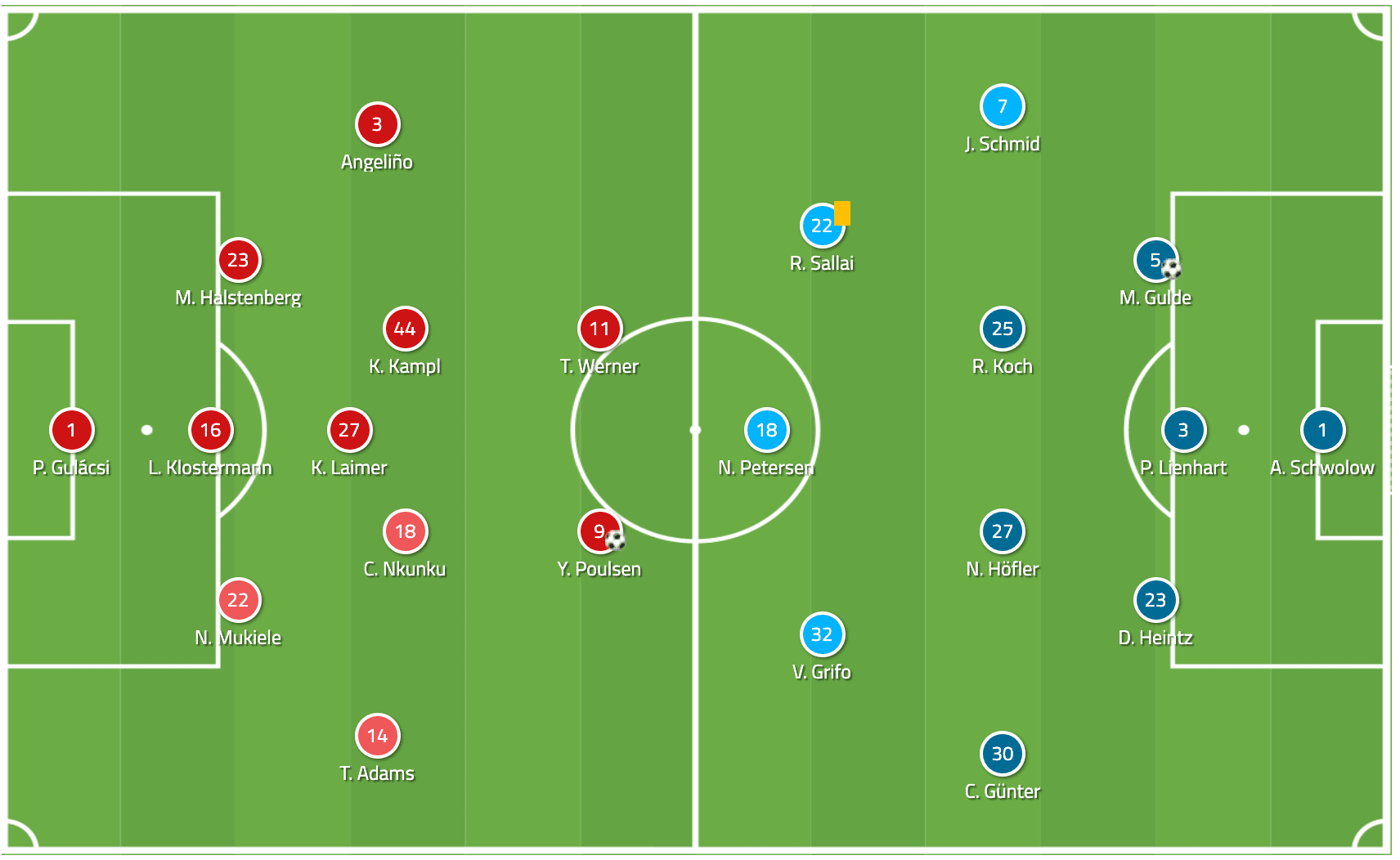
Naglesmann sent out RB Leipzig in a 3-5-2 with Péter Gulácsi in goal, although Leipzig’s shape proved to be quite fluid throughout the match. Marcel Halstenberg, Lukas Klostermann, and Nordi Mukiele started in the backline, which raised some eyebrows with Klostermann being the only “true” centre-back. Angeliño and Tyler Adams were on the left and right flank, respectively, with Konrad Laimer, Kevin Kampl, and Christoper Nkunku operating together in the centre of the pitch. In front of the midfielders were Timo Werner and Yussuf Poulsen.
Streich’s Freiburg were technically in a 3-4-3, although they spent a good majority of the match sewn up in their own half. Alexander Schwolow was in goal with Dominique Heintz, Philipp Lienhart, and Manuel Gulde in the backline. Christian Günter and Jonathan Schmid, both outside-backs by trade, were positioned on the wings, with Nicolas Höfler and Robin Koch in the centre of the pitch. The front three consisted of Vincenzo Grifo, Nils Petersen, and Roland Sallai.
RB Leipzig’s layered attack
While it’s been a while since most have seen live football, RB Leipzig’s attack didn’t seem to miss a beat, except, admittedly, their finishing. When not pinning Freiburg back into their own defensive third, Leipzig looked to exploit Freiburg through three different options: a quick build-up when Freiburg dropped off, a slower build-up, or their fast-paced counter-attacking. One would expect Leipzig to counter-press, which they did occasionally, although Freiburg attempted to limit the effectiveness of the counter-press by clearing the ball when under any immediate pressure.
One of Leipzig’s core principles of play is based around their use of multiple vertical passes to get up the pitch quickly. Leipzig gained possession in their own half with the ball slowly ending up at Angeliño’s feet after a header. Instead of looking to counter directly, Leipzig’s quick build-up through their vertical passing allowed them to create a chance.
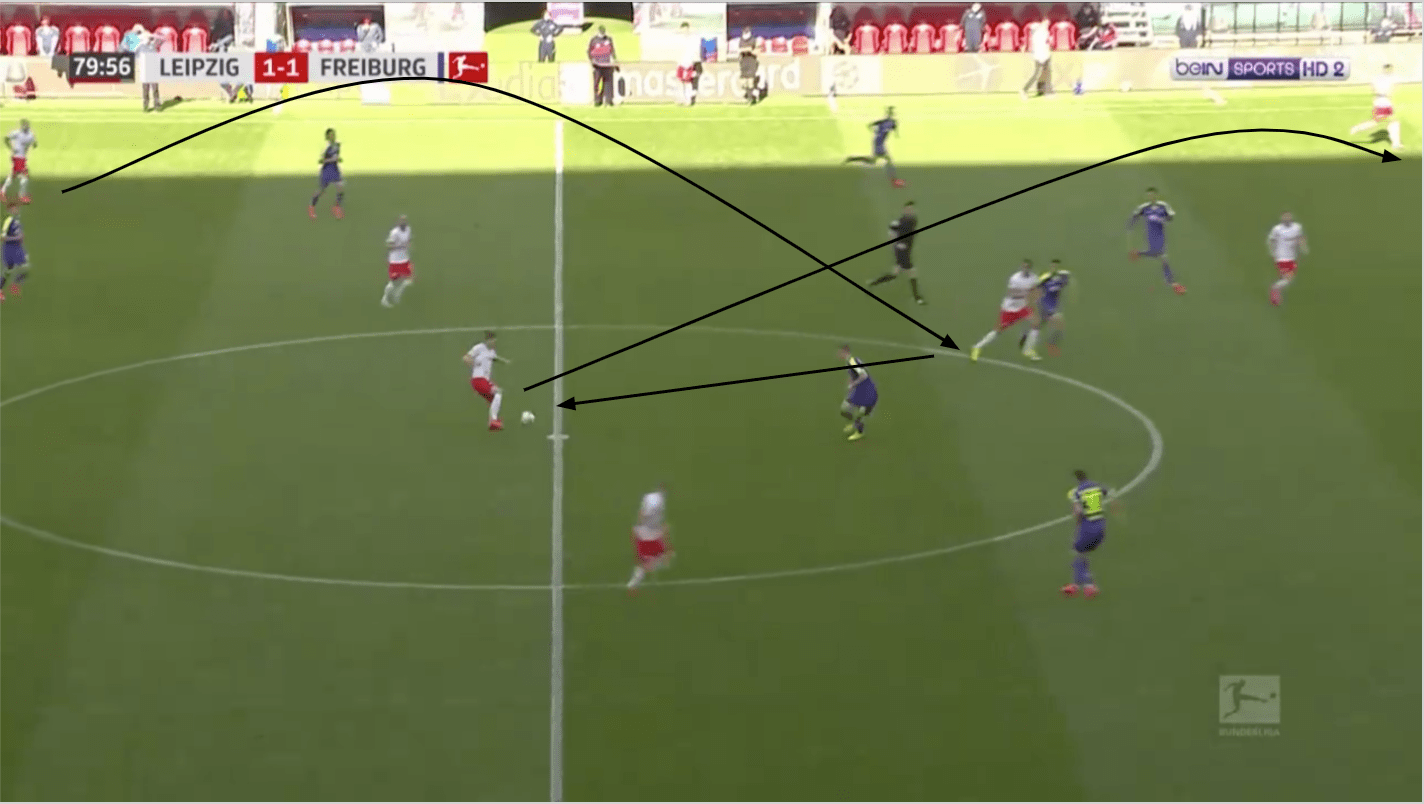
Angeliño’s first vertical ball found its way to Yussuf Poulsen, who was one of three men between Freiburg’s defensive lines. Poulsen laid the ball off to Sabitzer, who had a lot of time and space to receive the pass. This time and space was originally created by a combination of Angeliño and Poulsen’s passes. Angeliño got the defence moving backwards with a long vertical ball, causing them to rush backwards to defend. Poulsen then laid the ball off to the space the defenders had just vacated, where Sabitzer had a lot of room to ping his next pass towards Christopher Nkunku, who was occupying the left flank. Nkunku had multiple options arriving in the box, but his cross found Alexander Schwolow, Freiburg’s keeper, instead.
Early in the match, particularly before they had scored, Freiburg occasionally pressed higher up the pitch. When not attacking quickly, Leipzig looked to build a bit slower than normal, looking to draw defenders forward to create space in behind. One of the most interesting parts of their build-up in this situation was how they used Lukas Klostermann, their one true centre-back on the pitch.
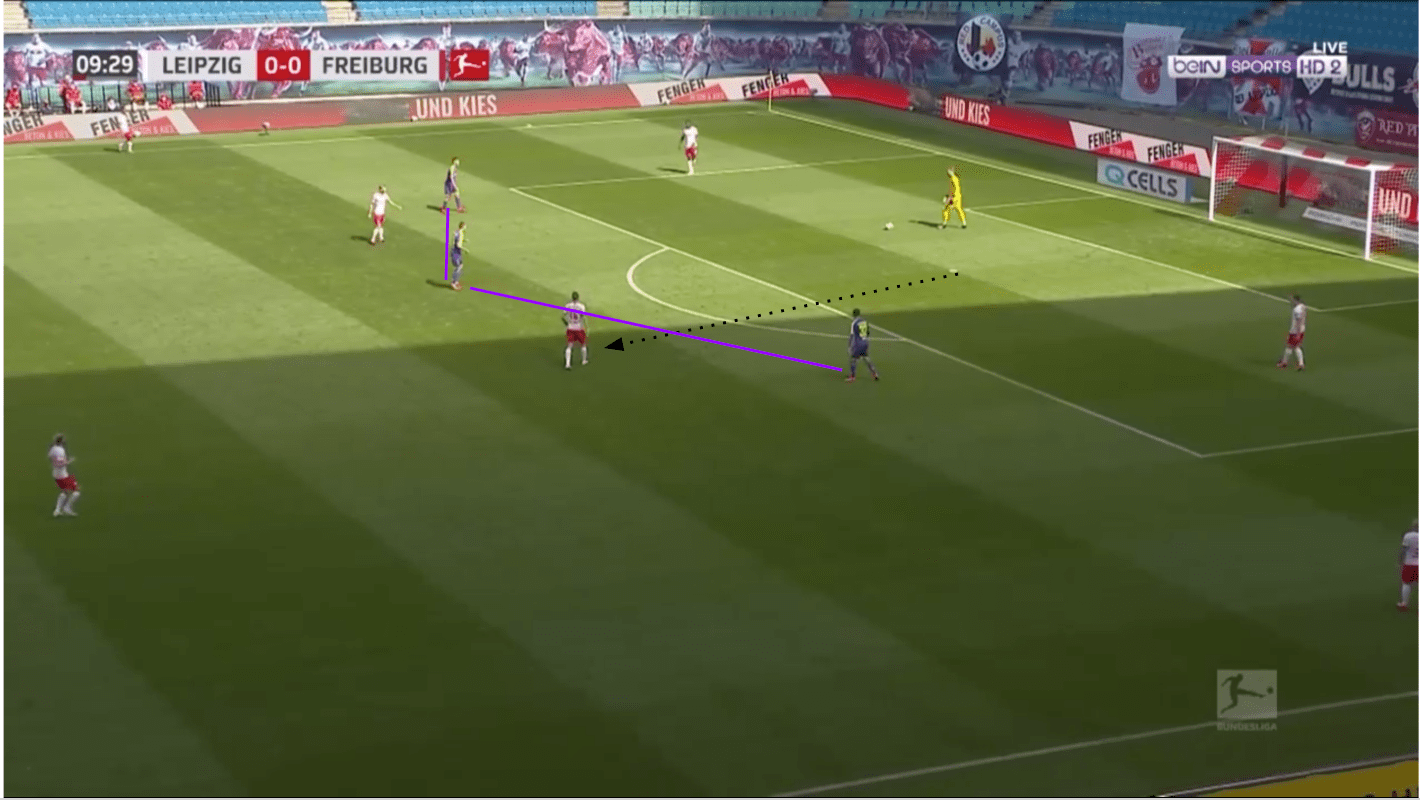
Klostermann would push up higher when Gulácsi had the ball at his feet. He and Konrad Laimer would position themselves in the space between Freiburg defenders. This positioning allows for multiple possibilities: it creates more room for the other two Leipzig centre-backs to receive the ball because those exterior wingers are less likely to press Halstenberg or Mukiele. If they did, they’d be allowing a central pass, which would likely have more immediate consequences. It also allowed Leipzig to more easily create numerical advantages on the wing at a quicker pace. When the ball went out wide, Freiburg would press, and Leipzig would quickly play through them by utilising their numerical advantage.
The final, most dangerous part of Leipzig’s attack when not surrounding Freiburg was through their counter-attack. Leipzig looked to get forward and exploit space in the centre of the pitch quickly after winning the ball back, catching Freiburg off-guard. Off of a Freiburg throw-in, Nkunku quickly had the ball at his feet, receiving a pass from Angeliño.
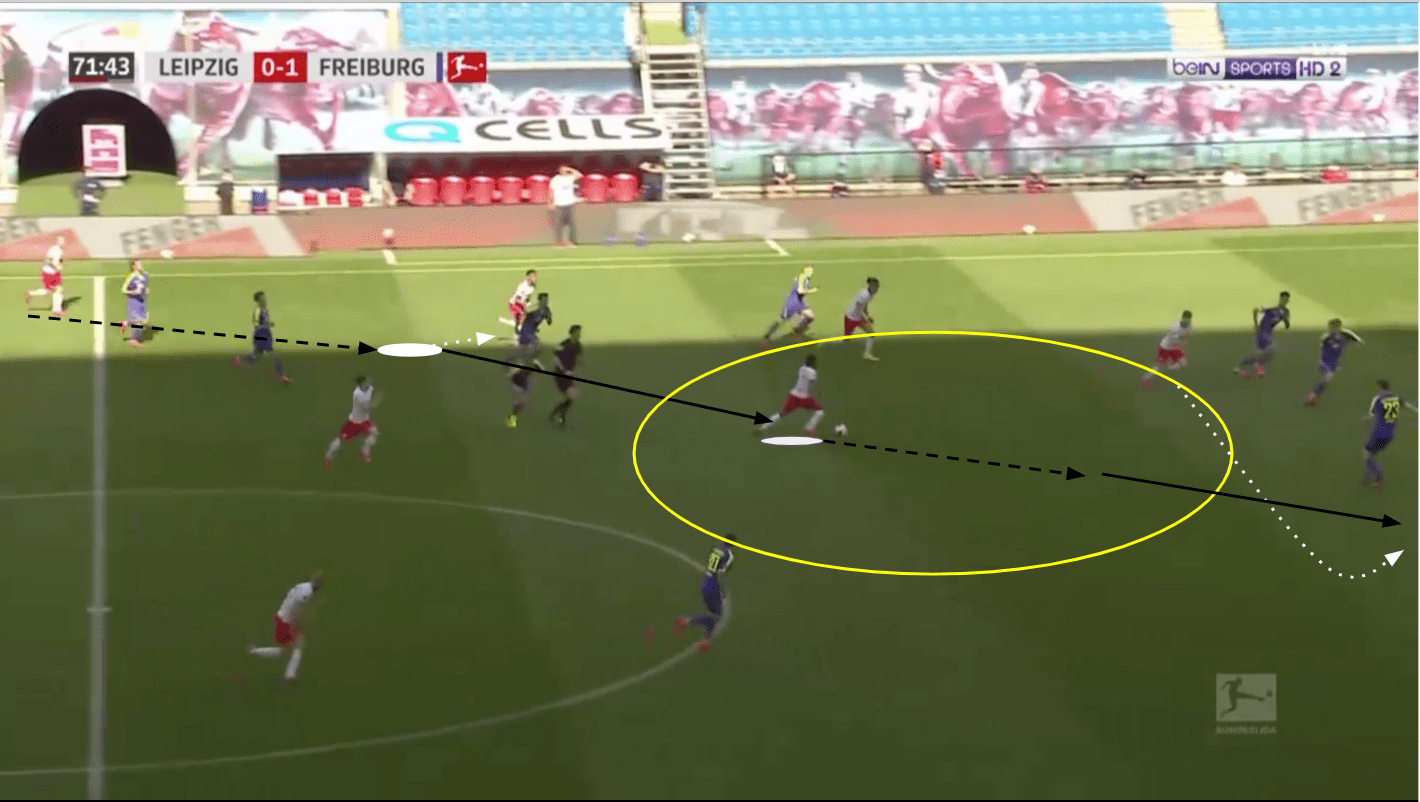
Nkunku dribbled and quickly found Ademola Lookman, who had come on for Mukiele. Lookman was intelligently positioned behind Freiburg’s midfield, and he was able to turn and dribble in space before slotting a pass to Werner, who pushed his shot just wide. These counter-attacks continued to occur throughout the match as Freiburg struggled to deal with the number of players Leipzig committed to the centre of the pitch.
Freiburg struggle in build-up
While Leipzig had a clear-cut plan for their build-up, Freiburg were not prepared to successfully build from their own half. Leipzig, just like Freiburg, were committing three to four men forward with support behind them. This created a numerical matchup with Freiburg’s back three, with the advantage for Leipzig being the speed of their front three. One way in which Freiburg looked to solve this problem was through Nicolas Höfler and Robin Koch, although it was usually Koch.
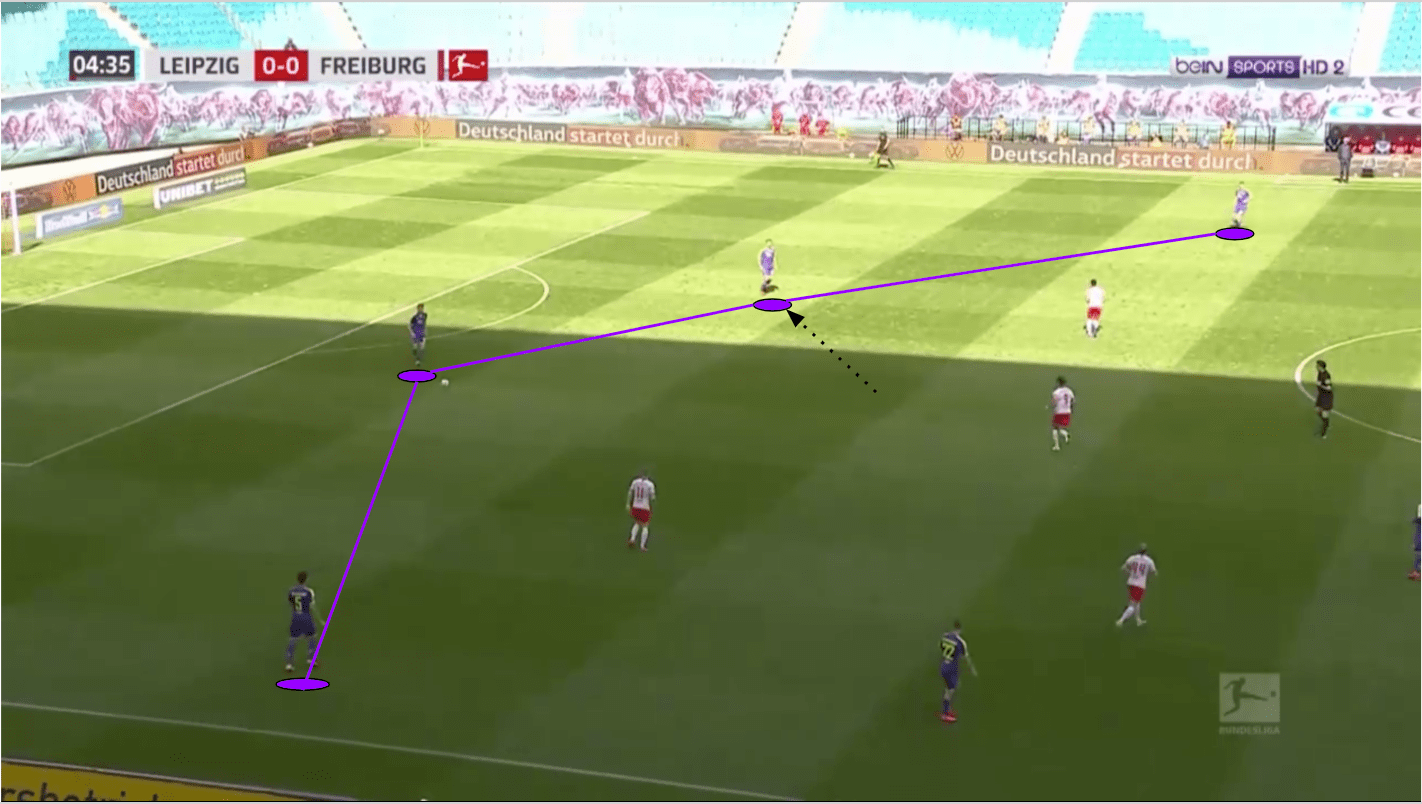
Koch would drop from his position in the midfield into the backline to create a makeshift back four. This allowed Freiburg to spread out more, spreading out RB Leipzig’s front three in the process. This would create more passing lanes for Freiburg to play into the centre of the pitch. However, they now only had two true central midfielders who could receive a pass, meaning they were outnumbered in midfield.
Them being outnumbered in midfield would mean that a better opportunity to progress up the pitch through the wing. While seemingly logical, Freiburg was unable to do so in the moment. In the image below, Höfler, the man on the ball, dropped almost to a left-back position.
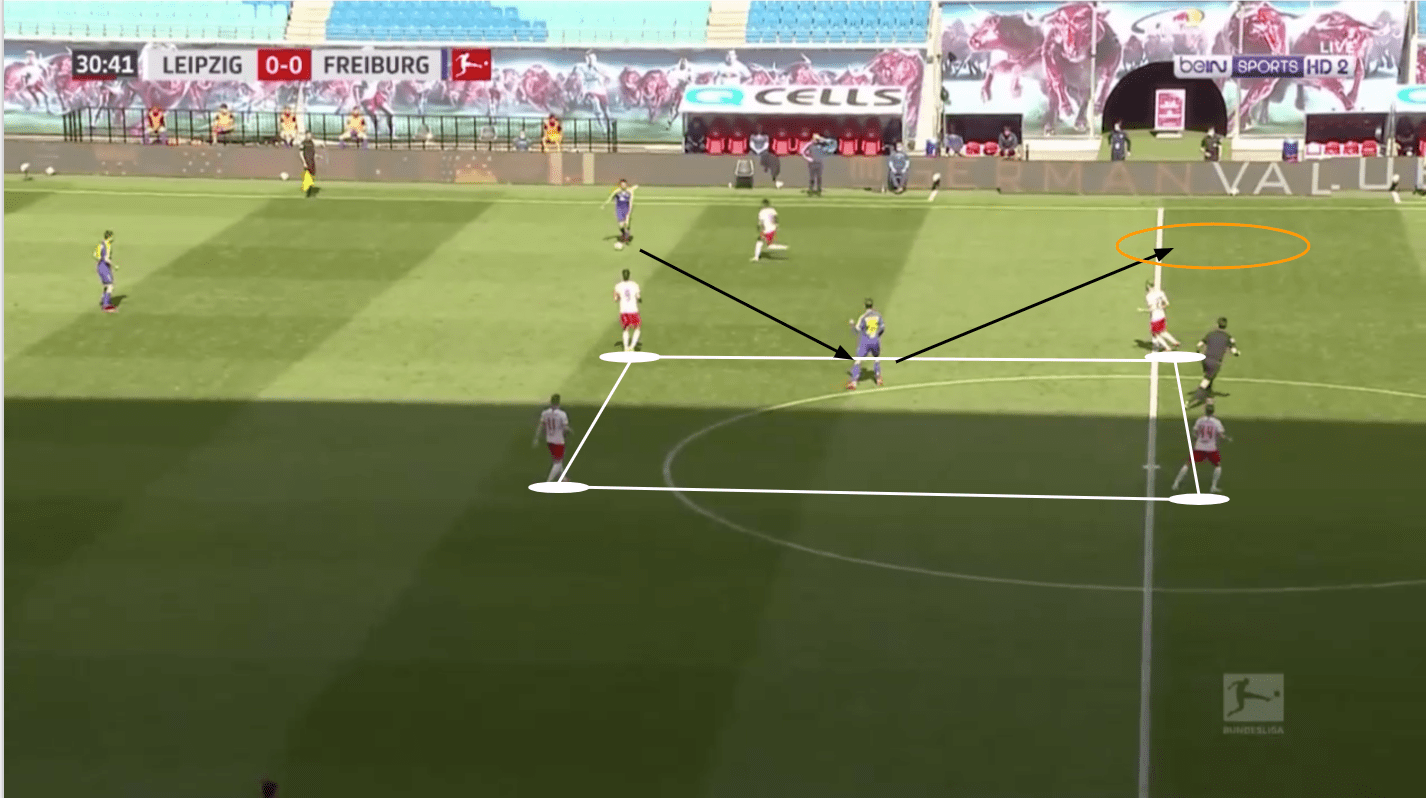
Doing so caused Christian Günter, who operated on the left-wing, to press higher up the pitch. Leipzig created this defensive box to protect the centre of the pitch while Nkunku pressed on the right-wing. Two quick hypothetical passes, above in black, would allow Freiburg to get up the pitch. However, that second pass isn’t possible because Günter was positioned much higher up the pitch. If Freiburg had an option to play there, it would give Leipzig a reason to hesitate when pressing. Instead, Freiburg weren’t able to create that option and eventually abandoned their build-up altogether.
Freiburg defensively compact
In the 34th minute of the match, Freiburg scored off of a somewhat lucky deflection on one of their corners. This goal was exactly what they needed, and they looked to close the match down by playing more conservatively. While this tactic is seen often in football, Christian Streich’s use of it was especially effective because it took away one of Leipzig’s strongest tools: their counter-attack. Even before the goal, Freiburg showed they were willing to pack their own defensive third and prevent Leipzig from playing through them.
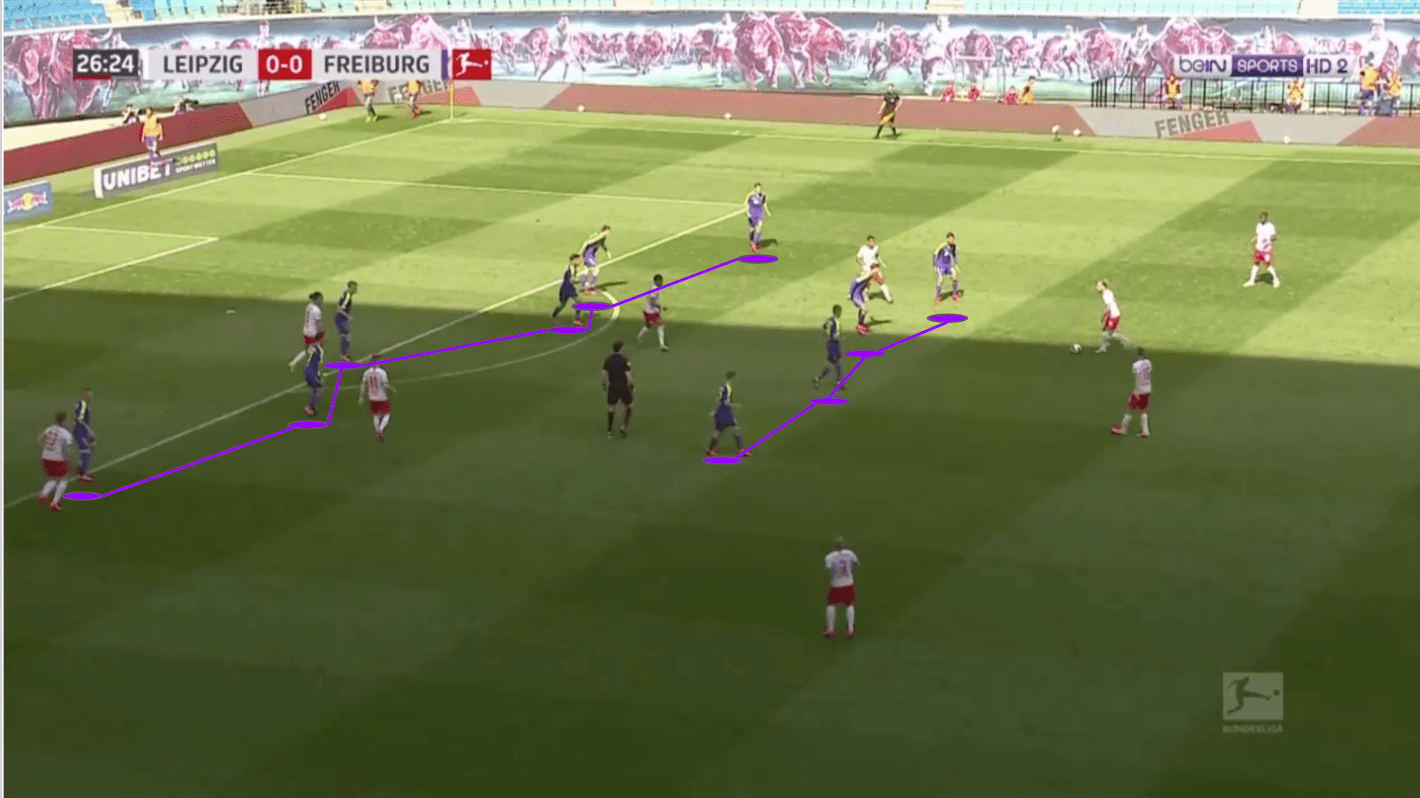
One of the ways they did this was by creating a 6-4-0 shape on the edge of their own box. Christian Günter and Jonathan Schmid, who both primarily play as outside-backs, dropped to help the back line, along with Höfler. Streich would probably have preferred Koch to drop, as he is a natural defender, but that’s the way the game goes. This block has effectively eliminated any chance of Leipzig to play through or around Freiburg successfully. In this instance, Kampl opted for a ball over the top, which was played back into the middle and the resulting shot missed the target.
Freiburg’s ability to maintain defensive fluidity in order to adjust to Leipzig’s attack are ultimately what led them to earning a point Saturday afternoon. Forwards were completely comfortable dropping into the midfield line in order to take up space, and midfielders were also able to do the same with the back line. The zonal marking displayed was quite impressive; if a man was pulled out of position by a Leipzig run, someone from a higher line would drop and “fill in” for that man.
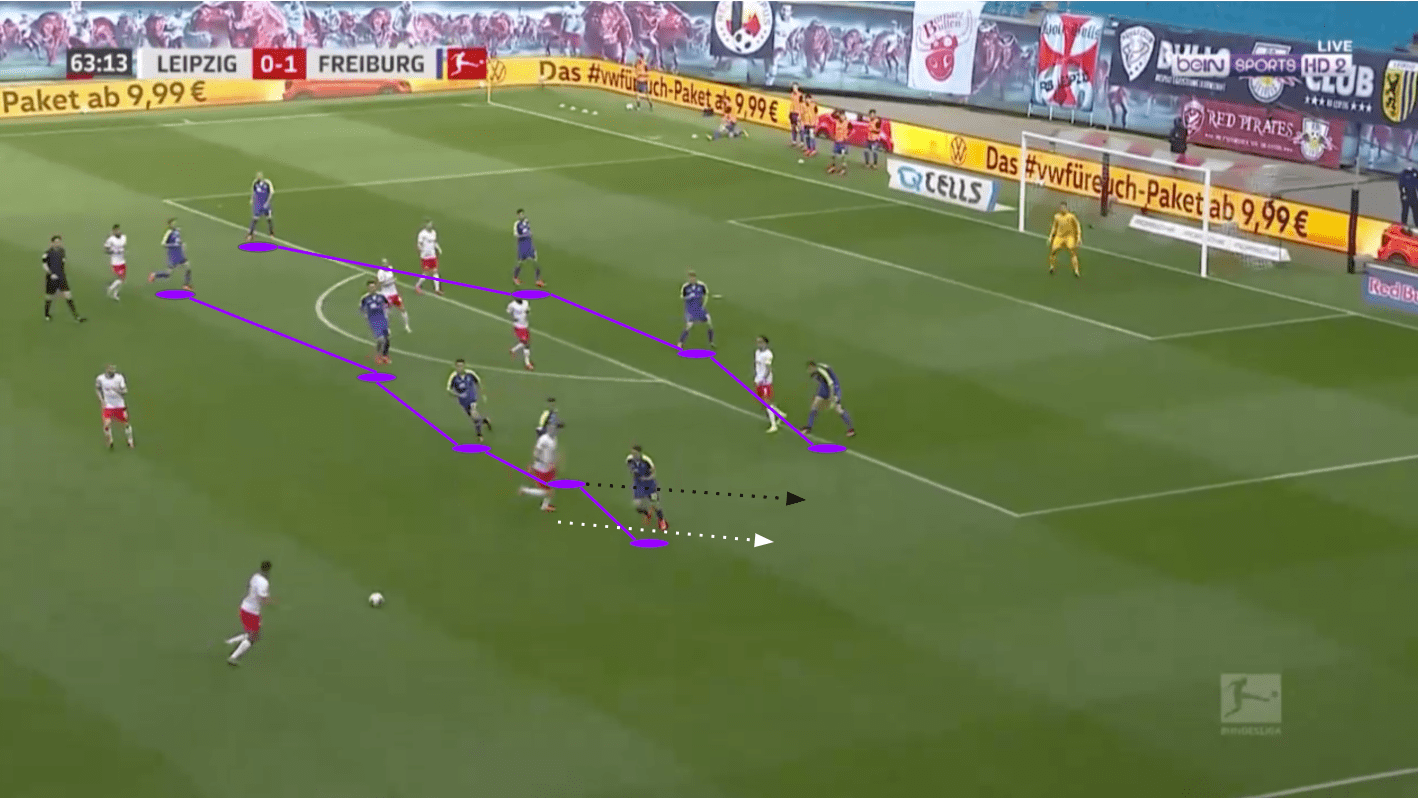
All their defensive efforts began in their own half as a 4-4-2, which was adjusted accordingly depending on Leipzig’s movement. In the image above, Klostermann’s run is tracked by Vincenzo Grifo. As Klostermann recycled his run and returned to his position, Grifo tucked into the midfield line, creating the above 4-5-1. This helped protect the inside of the pitch, with Freiburg remaining compact, both vertically and horizontally. As previously stated, the only real way for Leipzig to get through this was through the air, which becomes even more challenging when all those defenders are packed in tightly in positions where they can easily win headed balls.
Leipzig create positional advantage between lines
For much of the game, as previously mentioned, Freiburg felt comfortable packing men into their own defensive third in order to protect their goal. When they weren’t that compact, they still found a defensive shape in attempts to slow Leipzig down and prevent them from counterattacking. Leipzig’s response to having more possession than normal was to fill the centre of the pitch with men, preferably with men in between the defensive lines of Freiburg. Early on in the match, Leipzig made this priority clear.
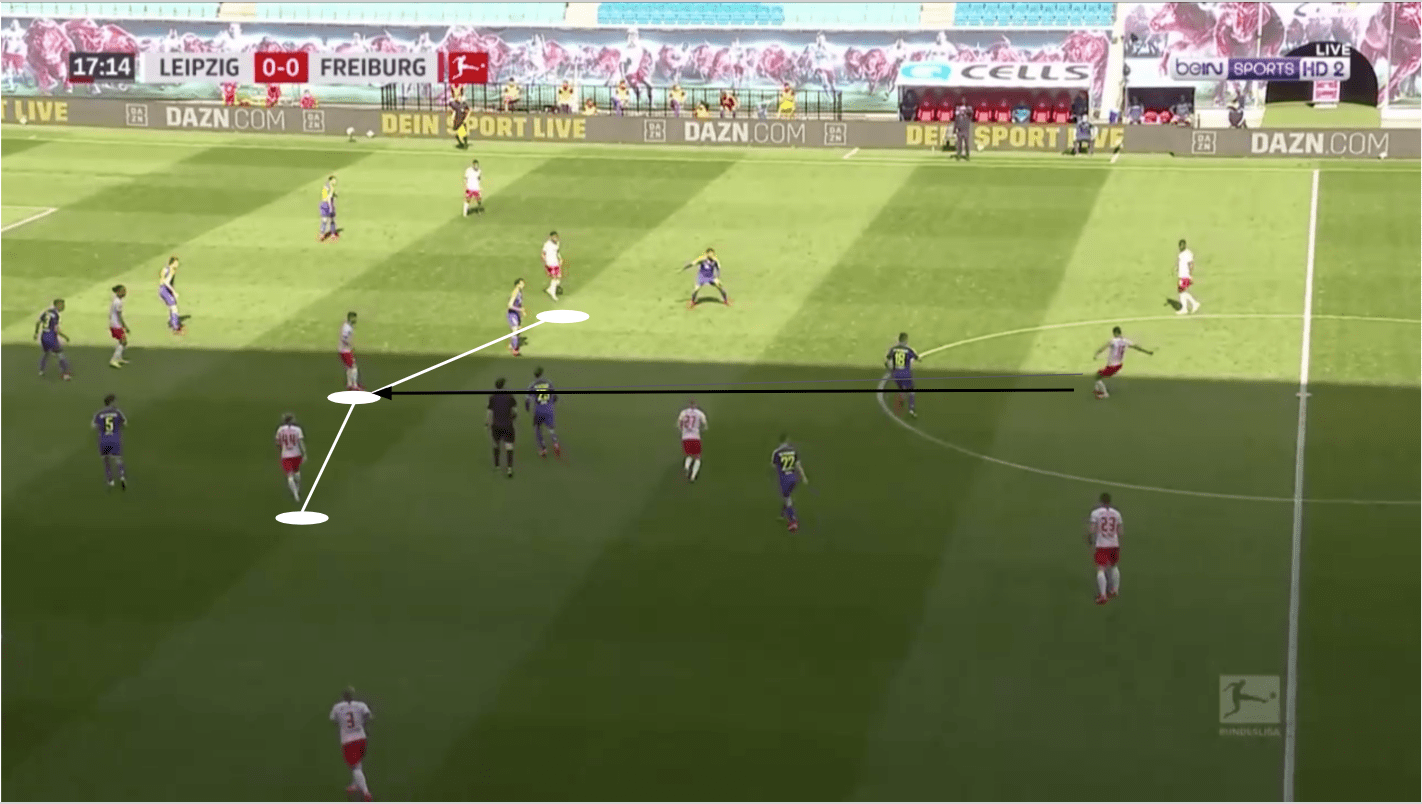
In the image above, Kampl, Werner, and Nkunku have successfully navigated themselves between the two defensive lines. What makes this positioning extra effective is the use of Kampl and Nkunku in their respective half-spaces. If those players can receive the ball there, especially when facing forward, they create a huge problem for Freiburg. The vertical pass executed by Klostermann eliminated multiple Freiburg players. While Werner didn’t turn towards the goal in this situation, he continued to get into this threatening position.
Technically, Leipzig switched to 4-2-2-2 in the second half, but this is largely irrelevant as they spent the majority of the second half pushing players forward in search of a goal. Much of that time continued with them attempting to get players in between the two defensive lines. In the image below, Kampl received a pass in that space, with time to turn.
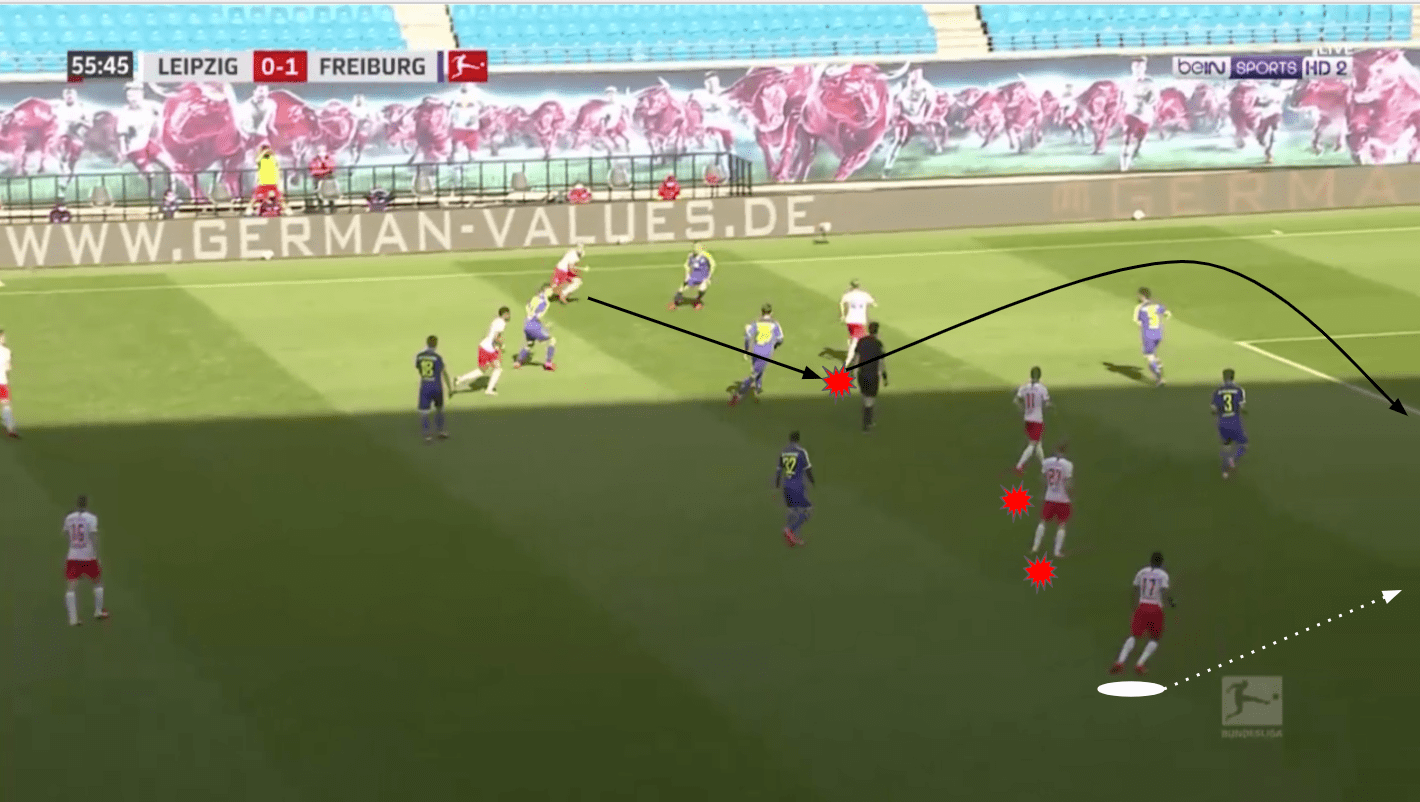
He turned towards the goal with his first touch. As he did, Freiburg’s defenders began marking men tighter, anticipating the cross that was coming. Poulsen, who is not in the image, was marked by the two centre-backs. The confusion with the four players that Leipzig had in the centre of the pitch allowed Lookman to make his run to the back post, completely unmarked. Kampl lofted a pass that landed perfectly on his right foot, but Lookman completely missed the target, missing one of Leipzig’s finest chances of the match. Kampl would later deliver a similarly lofted ball to the back post, and this time, Poulsen would finish the chance and bring the game level.
Conclusion
RB Leipzig continued to demonstrate their ability to dominate a match with their many layers of attack; however, Freiburg’s strong defensive efforts saw them earn a point. Leipzig now sit seven points out of first place, as Bayern Munich defeated Union Berlin on Sunday. Both teams need to quickly prepare for their next matches, as Leipzig take on Mainz next weekend while Freiburg face Werder Bremen. Both teams continue their push for a finish towards the top of the table, looking to gain entry to next season’s UEFA Champions League.





Comments